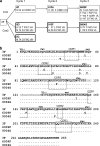Exploiting cross-reactivity to neutralize two different scorpion venoms with one single chain antibody fragment
- PMID: 21156801
- PMCID: PMC3057807
- DOI: 10.1074/jbc.M110.189175
Exploiting cross-reactivity to neutralize two different scorpion venoms with one single chain antibody fragment
Abstract
We report the optimization of a family of human single chain antibody fragments (scFv) for neutralizing two scorpion venoms. The parental scFv 3F recognizes the main toxins of Centruroides noxius Hoffmann (Cn2) and Centruroides suffusus suffusus (Css2), albeit with low affinity. This scFv was subjected to independent processes of directed evolution to improve its recognition toward Cn2 (Riaño-Umbarila, L., Juárez-González, V. R., Olamendi-Portugal, T., Ortíz-León, M., Possani, L. D., and Becerril, B. (2005) FEBS J. 272, 2591-2601) and Css2 (this work). Each evolved variant showed strong cross-reactivity against several toxins, and was capable of neutralizing Cn2 and Css2. Furthermore, each variant neutralized the whole venoms of the above species. As far as we know, this is the first report of antibodies with such characteristics. Maturation processes revealed key residue changes to attain expression, stability, and affinity improvements as compared with the parental scFv. Combination of these changes resulted in the scFv LR, which is capable of rescuing mice from severe envenomation by 3 LD(50) of freshly prepared whole venom of C. noxius (7.5 μg/20 g of mouse) and C. suffusus (26.25 μg/20 g of mouse), with surviving rates between 90 and 100%. Our research is leading to the formulation of an antivenom consisting of a discrete number of human scFvs endowed with strong cross-reactivity and low immunogenicity.
Figures




References
-
- Riaño-Umbarila L., Juárez-González V. R., Olamendi-Portugal T., Ortíz-León M., Possani L. D., Becerril B. (2005) FEBS J. 272, 2591–2601 - PubMed
-
- Dehesa-Dávila M., Possani L. D. (1994) Toxicon 32, 1015–1018 - PubMed
-
- Possani L. D., Becerril B., Delepierre M., Tytgat J. (1999) Eur. J. Biochem. 264, 287–300 - PubMed
-
- Rodríguez de la Vega R. C., Possani L. D. (2005) Toxicon 46, 831–844 - PubMed
-
- Chippaux J. P., Goyffon M. (2008) Acta Trop. 107, 71–79 - PubMed
Publication types
MeSH terms
Substances
LinkOut - more resources
Full Text Sources
Research Materials
Miscellaneous

